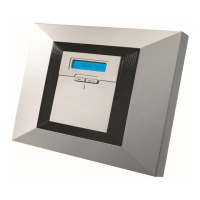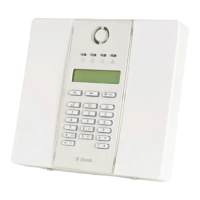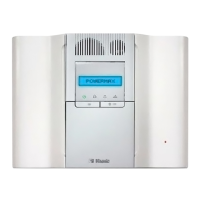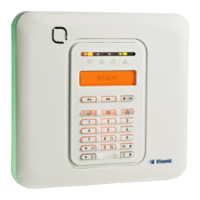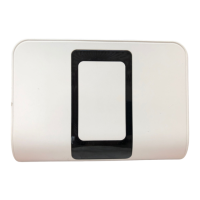6 DE5465
3.6 Connecting the AC Transformer
CAUTION! Do not plug the transformer into the AC
outlet before completing all other wiring.
A. U.S.A. only: Remove the center screw from the AC
wall outlet.
B. Plug the transformer directly in - the Power LED of the
control panel should illuminate.
C. U.S.A. only: Use the screw removed in Step A above
to secure the transformer to the AC outlet. Tighten the
screw well.
D. The distance of the transformer from the system should
not exceed 150 ft using 18 AWG conductors.
For UL installations, do not connect to a receptacle
controlled by a switch.
3.7 PowerMax+ Compatible Detectors
Each detector compatible with the PowerMax+ system is
packed with its own installation instructions. Read them
carefully and install as indicated.
A. PIR Motion Detectors
The wireless passive infrared (PIR) motion detectors used
in the system are of the PowerCode type. The PowerMax+
is capable of “learning” each detector’s identification code
and linking it to a specific zone (see Section 3 in the
Programming Guide). Some units are shown below:
Figure 4
NEXT
®
K9-
85 MCW
Figure 5
MCPIR-3000
or K-940 MCW
Figure 6
DISCOVERY
K9-80/MCW
MCPIR-3000 is not UL-listed!
Note: K-940 MCW, Discovery K9-80/MCW and NEXT
®
K9-85 MCW are pet immune units.
In addition to its unique 24-bit identification code, each
detector transmits a message, containing status information:
• The detector is in alarm (or not).
• The detector is being tampered with (or not).
• The battery voltage is low (or normal).
• “This is a supervisory message”.
If any of these detectors detects motion, it sends out a
message to the alarm control panel. If the system is in the
armed state, an alarm will be triggered.
B. Magnetic Contact Transmitter
MCT-302 (figure 7) is a PowerCode
magnetic-contact transmitter used to detect
the opening of a door or a window.
The
alarm contacts are closed as
long as the
door or window remains
closed.
Figure 7
MCT-302
The unit has an extra alarm input that acts as if it were a
separate wireless transmitter. It sends (or does not send)
a “restored to normal“ message to the alarm system,
depending on the setting of an on-board “DIP” switch. The
“restore” message informs you, through the control panel’s
display, whether the door or window is open or closed.
C. MCT-100 Wireless Adapter for Wired Detectors
(not UL-Listed) MCT-100 (fig. 8) is a
PowerCode device used mainly as a
wireless adapter for 2 regular magnetic
switches installed on 2 windows in the same
room. It has two inputs, behaving as
separate wireless transmitters with
different PowerCode IDs. Each input
sends (or does not send) a “restored“
message to the alarm system, depending
on the setting of an on-board “DIP” switch.
Figure 8
MCT-100
D. Wireless Smoke Detector
MCT-430 (UL-listed). A
photoelectric smoke detector
equipped with a PowerCode-type
transmitter. If enrolled to a fire zone,
it initiates a fire alarm upon
detection of smoke.
Figure 9. MCT-430
E. Glass Break Detector MCT-501
(not UL-Listed). An acoustic detector (fig.
10) equipped with a PowerCode-type
transmitter. Since it restores automatically
after detection, this unit does not send a
restoral message to the control panel.
Figure 10
MCT-501
3.8 PowerMax+ Compatible Transmitters
Note: Each transmitter is packed with its own instructions
for battery installation and use. Be sure to pass these
documents on to the “Master User“ of the alarm system.
The PowerMax+ system is compatible with multi-button
and single button key-ring and hand-held transmitters that
use PowerCode and CodeSecure coding methods.
Multi-button PowerCode transmitters transmit the same
code each time the same button is pressed. They can be
used for emergency signaling, for activating the PGM
output or for controlling appliances via X-10 units. They
can not be used for arming / disarming.
CodeSecure transmitters are of the rolling code type - they
transmit a new code each time the same button is
pressed. This provides a higher security level, especially in
arming / disarming applications, because the code can not
be copied (“grabbed”) by unauthorized people.
Following are the basic details of several compatible
transmitters. The possible applications for each push-
button are indicated in each drawing.
A. MCT-234 (Fig 11):
‘Keyfob’ transmitter - one
unit is supplied with
PowerMax+. You can
program the AUX (auxiliary)
button to perform various
tasks, in accordance with
the user’s needs.
Figure 11. MCT-234
B. MCT-231 / 201* (Fig. 12):
(N.A. in North America)
Single-button pendant units.
The MCT-231 (Code-
Secure) and the MCT-201
(PowerCode) can be enrolled
to perform functions as
shown. Both units look alike.
Figure 12. MCT-231 / 201
* Not UL listed.

